Second Life, What do the Students Think
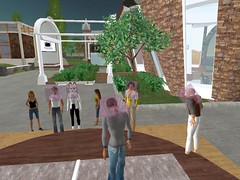
- Image by shornik via Flickr
As some might know I’ve been using Second Life in my financial accounting class at the University of Central Florida since the fall 2007 semester. Since that time my class size has gone from an average of 200+ to 800+. I have tweaked the learning objects each semester to try to improve the students learning experience, from the way the students interact with the 3-D accounting equation and interactive T-account to how they submit their homework, now employing automated homework boxes that examine the formatting of the data and the naming convention of the notecards that the students use. The homework on the notecards is now automatically read and sent to a MySql database and a confirmation e-mail is sent (well usually this works) to students so that they know they’ve submitted things properly.
As the occasional reader of this blog will know, well firstly I only occasionally post, but secondly I’m interested in using Second Life to engage my students in what surprisingly I’ve been told is a rather un-engaging topic. So I’m always listening to feedback from my students about my use of Second Life and the problems some of them have. In fact when asked how my students feel I usually reply that anecdotally the students fall into thirds: 1/3 really like it, 1/3 really hate it, and 1/3 just use it because it’s something that is required.
But as I prepare for the start of the Spring 2010 semester I thought I should look at some actual data to see how students feel. I am always cognizant of the cost/benefit of using Second Life for my students and for ME (as it takes up most of my time, answering orientation questions, grading non-automated HW assignments, dealing with students whose laptops aren’t powerful enough, etc.). And I wanted to see if the “noise” from the 1/3 “I hate it group” is causing me to actually inflate the size of that group – the old squeaky wheel thing going on.
So I looked at data I collect at the end of each semester. I ask my students to take a survey in which I ask for feedback on all the technology I use in the course: Second Life, Twitter, Concept Mapping software, My Accounting Lab, and Meebo (yes I know its a lot of technology for an accounting course). I’m not going to go over all the results to that survey in this post but want to examine one of the questions that I ask:
For each of the Second Life objects listed below, use the scale below to indicate your agreement with the following: I felt that the Second Life objects helped my understanding of the underlying accounting concepts in acg2021
These are the results:
For Fall 2009 40.7% of the students agreed or strongly agreed that Second Life helped them understand the underlying concepts of financial accounting! And it’s actually better then that. Included in the average % is data related to students who used Second Life to watch my lectures (as opposed to using a website – though 15% of students did report they watched lectures at least some of the time via Second Life), removing that and just examining how the students felt the learning objects helped them to understand the underlying concepts of financial accounting we see that 47% of the students agreed or strongly agreed that Second Life helped them to learn accounting! Wow! So how do previous semesters stack up, here they are:
Spring 2009
Fall 2008
Spring 2008
You will notice that when class sizes are relatively smaller more students felt that the use of Second Life helped them to understand the accounting concepts, those students who agreed or strongly agreed overall represented 55.5% and 58.6% when using just the learning objects.
Fall 2007
The number’s here are comparatively low, but during this semester Second Life was voluntary and not a required component of the course.
So (and BTW if you’re still reading this far down, thanks!) I would say that any tool in which 40% or more students agree helps them to understand accounting is well worth the effort.
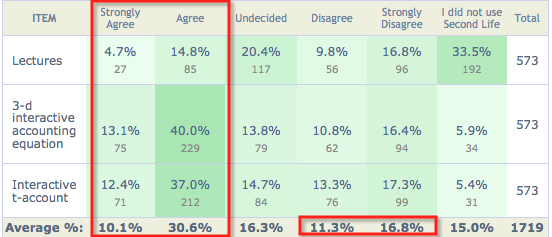
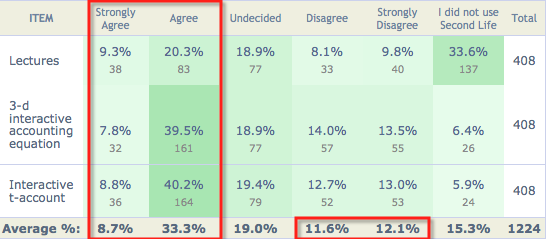
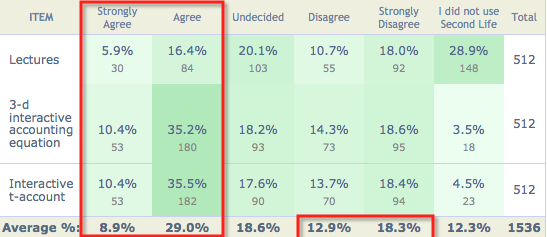
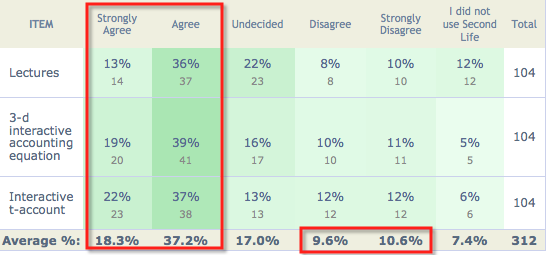
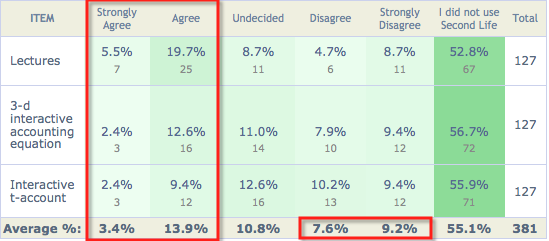


It’s interesting to see the numbers behind these efforts. Do you have any idea what the primary issues were for the 27-28% who were in the disagree or strongly disagree category?
In case this is helpful for folks, I wrote a blog post showing how to optimize the Second Life viewer for lower performance machines – feel free to hand it around if it’s useful:
http://joelfoner.com/2009/12/8-ways-to-make-low-perf-computer-second-life-faster/ (It’s actually 10 ways now 🙂
Best regards,
Joel
That 25% or so of students don’t “get” SL seems to be a recurring theme in mant courses. However, I believe the Loyalist College folk have overcome it to some extent with their Canadian Border Crossing sim so I don’t think we should assume it is a given. I agree that further data on this aspect would be very valuable. Nice work, Steve — I’m in awe of your class management skills.
Just as in any learning experience, you’ll have differing personalities and styles of accessing information. Second Life opens some channels and overwhelms others. The key is to recognize it’s strengths and not expect it to serve all participants in the same manner. That said, I remain impressed at the ability of virtual environment’s to shift our perceptions, and create trans-formative change.
Great coursework, fantastic study. As said upthread, different channels for different learning affinities.